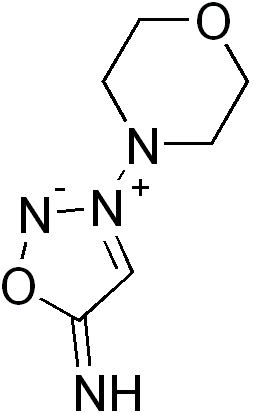Linsidomine
 | |
| Clinical data | |
|---|---|
| ATC code | |
| Identifiers | |
| |
| PubChem CID | |
| E number | {{#property:P628}} |
| ECHA InfoCard | {{#property:P2566}}Lua error in Module:EditAtWikidata at line 36: attempt to index field 'wikibase' (a nil value). |
| Chemical and physical data | |
| Formula | C6H10N4O2 |
| Molar mass | 170.17 g/mol |
|
WikiDoc Resources for Linsidomine |
|
Articles |
|---|
|
Most recent articles on Linsidomine Most cited articles on Linsidomine |
|
Media |
|
Powerpoint slides on Linsidomine |
|
Evidence Based Medicine |
|
Clinical Trials |
|
Ongoing Trials on Linsidomine at Clinical Trials.gov Clinical Trials on Linsidomine at Google
|
|
Guidelines / Policies / Govt |
|
US National Guidelines Clearinghouse on Linsidomine
|
|
Books |
|
News |
|
Commentary |
|
Definitions |
|
Patient Resources / Community |
|
Patient resources on Linsidomine Discussion groups on Linsidomine Patient Handouts on Linsidomine Directions to Hospitals Treating Linsidomine Risk calculators and risk factors for Linsidomine
|
|
Healthcare Provider Resources |
|
Causes & Risk Factors for Linsidomine |
|
Continuing Medical Education (CME) |
|
International |
|
|
|
Business |
|
Experimental / Informatics |
Editor-In-Chief: C. Michael Gibson, M.S., M.D. [1]
Overview
Linsidomine (3-morpholinosydnonimine or SIN-1[1]) is a vasodilator. It is a metabolite of the antianginal drug molsidomine and acts by releasing NO from the endothelial cells nonenzymatically. It also hyperpolarizes the cell membrane through influencing the sodium-potassium pump and thereby rendering it less responsive to adrenergic stimulation. Linsidomine injection at a dose of 1 mg produces usable erection in about 70% of patients and full erection in up to 50% of patients. Linsidomine does not appear to be associated with priapism.
Linsidomine is neurotoxic and promotes oxidative stress on neurons.[2] Linsidomine is a peroxynitrite-generating compound involved in the pathogenesis of neurodegenerative diseases.[3]
References
- ↑ Wen, TC.; Rogido, MR.; Moore, JE.; Genetta, T.; Peng, H.; Sola, A. (Oct 2005). "Cardiotrophin-1 protects cortical neuronal cells against free radical-induced injuries in vitro". Neurosci Lett. 387 (1): 38–42. doi:10.1016/j.neulet.2005.07.018. PMID 16084018.
- ↑ Wallace, DR.; Dodson, S.; Nath, A.; Booze, RM. (Jan 2006). "Estrogen attenuates gp120- and tat1-72-induced oxidative stress and prevents loss of dopamine transporter function". Synapse. 59 (1): 51–60. doi:10.1002/syn.20214. PMID 16237680.
- ↑ Jang, JH.; Aruoma, OI.; Jen, LS.; Chung, HY.; Surh, YJ. (Feb 2004). "Ergothioneine rescues PC12 cells from beta-amyloid-induced apoptotic death". Free Radic Biol Med. 36 (3): 288–99. doi:10.1016/j.freeradbiomed.2003.11.005. PMID 15036348.
- Pages with script errors
- Pages using duplicate arguments in template calls
- E number from Wikidata
- ECHA InfoCard ID from Wikidata
- Chemical articles without CAS registry number
- Articles without EBI source
- Chemical pages without ChemSpiderID
- Chemical pages without DrugBank identifier
- Articles without KEGG source
- Articles without InChI source
- Articles without UNII source
- Drugs with no legal status
- Articles containing unverified chemical infoboxes
- Cardiovascular Drugs
- Drug
- Vasodilators